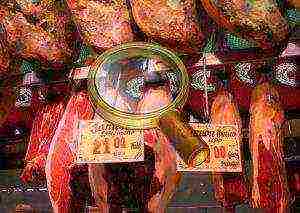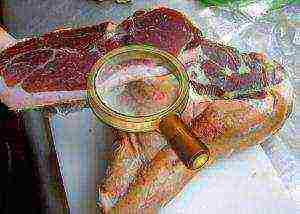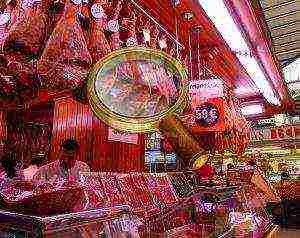Content
|
You will not surprise anyone with a pork ham; it is used to prepare delicacies in all countries where pigs are bred. But the Spaniards managed to create a cult of their pork ham, calling the delicacy simply - "jamon" (translated as "ham"). The taste of Spanish jamon is incomparable to any other. You will see hanging pork legs in all Spanish restaurants, markets, catering establishments, even if they specialize in a different cuisine, and in ordinary Spaniards' kitchens. It is impossible to imagine the national cuisine of Spain without jamon. Jamon is everywhere in Spain. And since this is a national pride and a national dish, we cannot but tell about it in detail. Many tourists bring home this delicacy from Spain as a gift, and if you decide to buy it, it is advisable to be able to choose it and know the price of popular varieties. Types of jamon - when the breed plays an important roleJamon serrano - ham from the hind leg of white pigs. These are the most common breeds that are grown in Russia, France, China and other countries. This is "mountain ham". But the modern variety of this meat dish has nothing to do with the mountains. Now only the name remains, but before the pigs were grazed in the mountains and then their hams were used to make jamon. Jamon iberico. Made from special Iberian pigs. Not only do they “wind” kilometers during their short pig life, so fat is evenly distributed throughout their bodies, but also their nutrition is special: acorns. The legs of this breed of pigs are elongated, and the meat is distinguished by a special marble color. There are several breeds of Iberian pigs: from Estramadura black and brown, from Andalusia light, Torviscan and Jabugo. In Spain, the purity of the breeds is strictly monitored, and mixing can lead to the deprivation of the quality certificate. |
||
How the Iberian variety is madeIt is made only from the hind legs of the pig. The ham from the front legs is called "pallet" in Spain, and it is not suitable for jamon. The back leg of pork weighs up to 14 kg, from which the ham will turn out to be 7-8 kg, of which there will be only 4-5 kg of meat, the rest is bone. Before getting to the butchers, the pig must gain 150-180 kg. Animals are raised free-range. And the taste of meat will depend not only on the breed of the pig and on the technology of preparation of the ham, but also on the diet of the animals. The finished ham will indicate the option for feeding the Spanish pig. And he happens to be of these types. 1. de cebo: pigs grew up in pigsties, were sedentary in their short lives, and ate legumes and grains from 10 months and up. This option is the most affordable. 2.de cebo de campo: pigs were fed mixed, acorns and fodder, on a pasture of 100 sq. meters per pig. They grew them for a year or more. This jamon is more expensive. 3. de bellota: pigs are raised for more than 14 months, of which 3 months they were in the pasture. They ate exclusively on acorns. This jamon is the tastiest and most expensive. In the photo above, see the iberica de cebo variety on the right. Click on the photo to enlarge. The path from a simple ham to a Spanish national dishFor the first time, salting of pork meat to preserve the product was done by the Cantabrian peoples, who were enslaved by the Romans around 29-19 BC. The recording of the recipe for salting meat was first made by Cato the Elder in the 2nd century BC. e in the book "De re agricola". Already in that early period of Spanish history, the Spaniards used the method of salting pork for storage and transportation. The Romans saw the culinary delights of the Spaniards, and the whole empire soon learned about it.This miracle innovation is mentioned in the records of the emperors Diocletian and Martial. In his letters, the famous ham is mentioned by the military poet and historian Marcus Varro. Jamon saved poor families from hunger, armies on campaigns, decorated the tables of emperors, nobles, and was sold in ordinary markets. During the discovery of America, participants in expeditions and transatlantic crossings ate Castile bread and lard from Iberian pigs. Through the colonies in the 18-19 centuries, most countries on all continents got acquainted with the Spanish ham. In Spain, jamon is made throughout the country, except for the coast, since the climate there is not conducive to the production of a national dish. Spanish hams, like wines, have their own quality mark - Denominacion de Origen. Its standards are strictly followed for each province. Monitors the quality of the Consorcio del Jamon Serrano Espanol product. |
||
|
However, even after many centuries, the recipe for making ham has remained unchanged. First, the meat is salted for 7 days or more, then it is washed and dried in special rooms. It's a few more months. Then "ripening" takes place for 9-12 months in bodegas (special cellars). Then the finished product is checked for quality by making a hole in the ham with a thin long needle. The aroma indicates the successful completion of the preparation. Where to buy Spanish hamIt is difficult to get any serious benefits from the correct choice of the place of purchase, the quality is about the same everywhere, it depends more on the variety. Prices are almost the same. The only advice: choose outlets where the Spaniards themselves buy, not tourist places. A meat delicacy is sold everywhere: in butchers' shops (the photo on the left is an example of such a shop in Spain, click on the photo to enlarge), in shops, in supermarkets, in restaurants, directly in production, where organized trips of tourists are arranged. What are the prices for a delicacy?A leg weighing 8 kg will cost 150-200 euros. Jamon, marked with a special quality mark DOP (Denominacion de Origen Protegida), will cost about 80 euros and more per 1 kg. The Belotta variety is sold up to 300 euros per 1 kg. If you want to please all family members, relatives and friends with a quality ham, then stock up on money and expand your budget for gifts. Read in detail in our article "How much money to take to Spain". In almost every major city in Spain, there is a jamon museum, where hams are tasting of different varieties with different aging. You can choose to taste and bring it as a gift to your homeland. In Spain there are special establishments for tasting all kinds of jamon and they are called "jamoneria". What to look for- The carcass must be stamped with the year and week of manufacture, and from the date of purchase, the entry on it must be at least two years away. In the photo next to you can see the brand name, click on the photo to enlarge. - One of the words Bodega, Reserva or Curado will be added to the name of the Serrano variety. This is the aging period of meat in the cellars: 12, 9 and 7 months, respectively. - A real jamon will cost at least 15 euros per 1 kg. - The variety must be indicated in the name of the product. - Examine the exterior of the carcass: it should be with a hoof, no hair and have a flattened shape. - Jamon is never sold in a vacuum package, so if you see a wrapped ham (we are talking about a whole leg), immediately look for another place to buy. |
||
How to eat jamon in order to feel all its unique tasteThe culture of eating a national dish assumes several important points that should be taken into account and observed. The delicacy is kept at a temperature of 15-20 degrees, it is not put in the refrigerator. After the ham has been cut, it is stored for no more than six months. Grease the incised area with olive oil, then cover with a paper towel. Always cut off as much as will be eaten.Cut the meat part as the cardadors do (meat slicers in Spain, in the photo below, click on the photo to enlarge) - in thin long pieces, use a narrow, long and sharp knife. Hamonera is used for slicing - a special stand made of wood. Just above the hoof, the leg is attached to the screw, and the rest is placed on the board. They eat the delicacy with olives, washed down with sherry, red wine or beer (if the first two drinks are not found). Ham is often combined with melon or figs. Bread is excluded during tasting, as it overpowers the taste of the meat. In Spain, jamon is used to make tortilla omelet, fried mushrooms, and tuna steaks. The remaining bone is used to make a broth for the garbanzo pea soup. Pieces of jamon are taken by hand, no forks. Jamon is popular in sandwiches in Spain, just like we have raw smoked sausage. The Spanish McDonald's even released a seasonal Mc Iberica sandwich, it cost 6.35 euros, was not very popular and was removed from the main menu. But the Spaniards took jamon very warmly as part of the pizza, now half of the pizzas in Spain are made with jamon. Happy tastings of Spanish dishes, and read interesting reviews about this country on our website (links below).
|
||
|
The culinary signature of Spain is made from pork legs. For the production of ham, strictly the hind limbs are taken. From the front ones, from which another meat delicacy is made - a pallet, they compare favorably with the ratio of fat, bones and meat, where the latter can reach 60% of the total weight of the leg. The ham is salted, dried, and then sent to the cellars and dried in natural conditions.
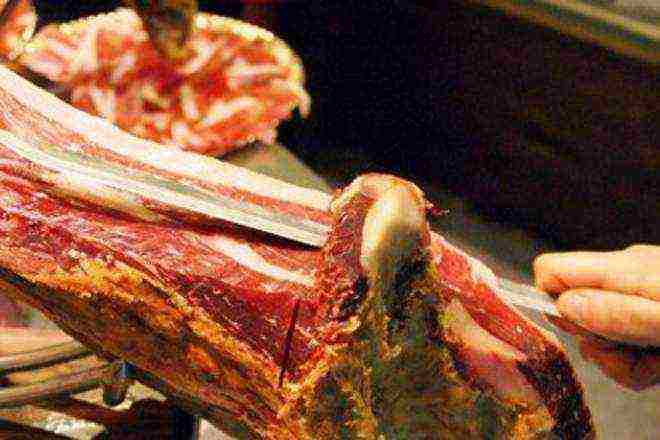
Depending on the breed of pigs, jamon is divided into two varieties: Serrano and Iberico. The first is made from pigs of the white breed, which are fed mainly with grain. The second, most expensive type of jamon is made from the ham of the black Iberian pigs. The animals are raised in open pastures, and their diet consists of only acorns and compound feed.
The quality and cost of jamon determines the conditions for raising pigs and their menu. According to the type of diet of Iberian pigs, jamon is distinguished:
de cebo - the menu consists of compound feed;
de cebo de campo - a mixed type of menu consisting of acorns, herbs and grains;
de recebo - pigs feed on acorns and grass, and if they do not gain the required weight, then cereal feed is added to the menu;
de bellota - pigs are kept exclusively on an acorn diet.
De bellota represents the most expensive variety of Iberico jamon. The price for it can be as high as 300 euros per kilogram.
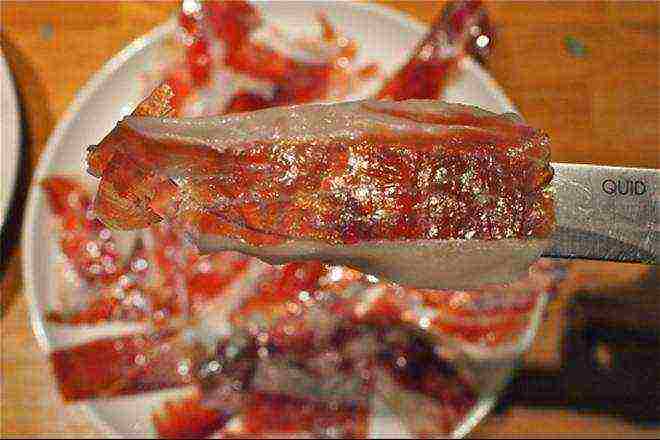
The hallmark of the ham is the hoof. For Serrano it will be white, for Iberico it will be black. Other physical aspects, such as length and shape, are used to assess the quality of the product. Thin hooves of equal length and long tops indicate that the product is of high quality.
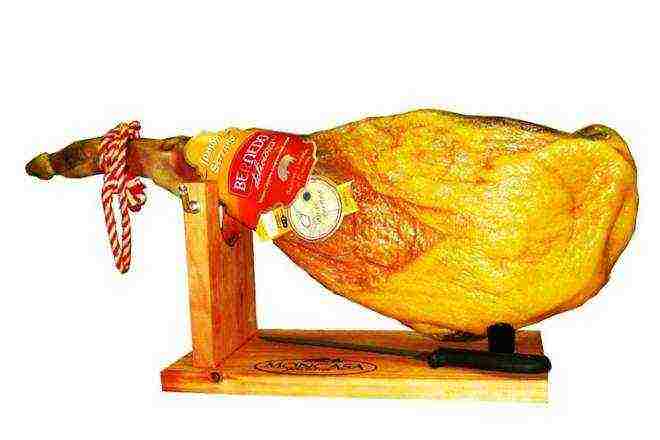
The quality of the Iberian ham can also be identified by the abbreviation D.O. on the packaging, which means "guarantee of origin". Next to it is the name of the province in which the ham was produced according to local standards. Such signs have several areas: Guijuelo, Cecina de León, Dehesa de Extremadura, Jamón de Huelva, Jamón de Teruel and Jamón de Trevélez.
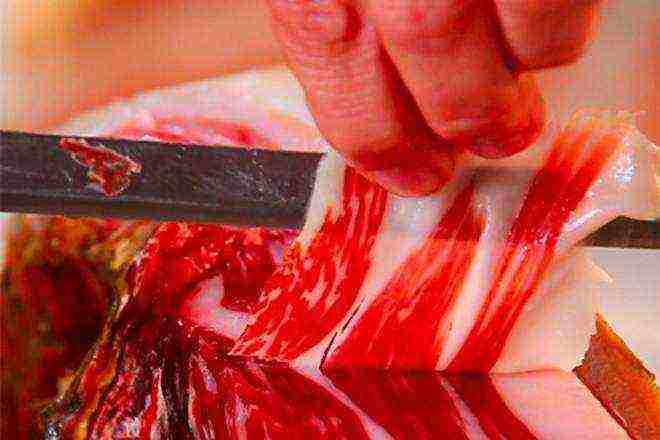
The fat of a high-quality Iberico jamon is very fusible. It is enough to press on the outer fat with your finger, and the fat begins to melt, leaving a small mark. The color of the fat can range from light yellow to light brown, indicating that the ham has been aged under the correct conditions.
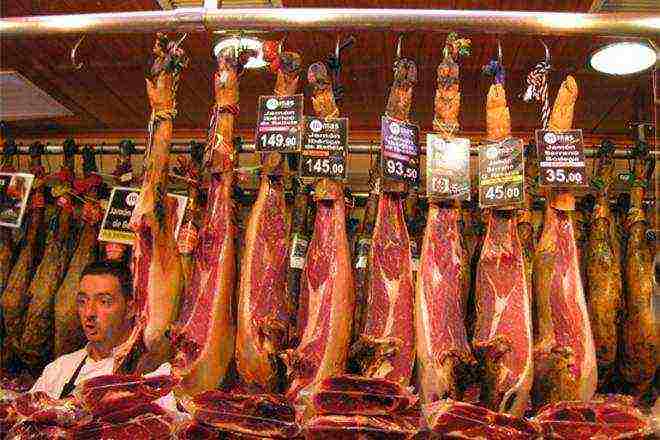
Since the leg continues to wither even outside the basement walls, it will not be superfluous to carefully study the stamp on the leg, which indicates the timing of the start of salting and its duration. Additional aging of the ham gives the meat a more intense aroma and taste only up to a certain time, and then the leg begins to dry. For jamon, this period is limited to a year.
Leg weight ranges from 6.5 to 9 kg. A whole leg is kept at room temperature by simply hanging it from the ceiling of a store, restaurant or kitchen. So that the leg does not dry out, it is recommended to cut at least 50 grams of ham a day. They eat jamon without everything or a bite with a melon and be sure to drink it with a glass of red.
I can bet that the vast majority of tourists returning from Spain bring with them either the ham itself, or, in less fortunate circumstances, long tasty stories and memories of this gastronomic miracle. Of course, there are exceptions when people do not penetrate and find it hardly edible, but no one remains indifferent - this is a fact. What should these tourists do, who by any means want to prolong their pleasure and are trying to find the "correct" jamon in our stores, and how not to run into a fake for those who still arrive in Spain and can get the goods, as they say, first-hand. What you need to know, where to look, where to smell and where to poke - we'll figure it out together.
First of all, what is jamon in general and with what, as they say, it is eaten.
To begin with, we are dealing with pork legs, or rather, with their dried version. But not every leg is called a ham, everything is strict here. Distinguish:
PalletFront pork leg. Its peculiarity is a much higher weight of bone and fat relative to the specific gravity of meat. For example, when buying a whole pallet with a total weight of 3-4 kilograms, you will receive meat directly, at best, 1-1.5 kilograms. The front leg is better, more uniformly dried, but some gourmets, at first glance, attribute this plus to the minuses. They argue that the palette of taste becomes scarce from this, loses shades at the transitions from the outer layers to the inner ones. The pallet has the shape of a crescent and the leg weight ranges from 3-4 kg with a maximum indicator of about 6 kg.
JamonThe hind leg of a pork is characterized by a bone-fat-meat ratio of approximately 30% -10% -60%. The ham must be salted and dried in natural conditions, technologies that are more than a dozen years old are relevant and valid to this day.
There are two main varieties of jamon - jamoniberico (iberico) and jamonserrano (serrano), the main difference between which is different breeds of pigs and different diet compositions for each of them.
Jamonserrano (serrano)
It is made from our relatives, familiar from childhood, pink domestic pigs. It is on such a jamon that you can most often see the word "kurado", which simply means "dried", and also means the fact that under this brand you can sell anything, even a little related to a real jamon. In fact, curado is the cheapest version of jamonaserrano. The low price, as well as the coveted word on the label (jamon), make curado a great selling option. But that's not what we came for. If we are interested in a real Serrano, then curado is not our option.
Jamonaserrano classificationDepending on the length of the ripening period on the label, you will be able to observe the following inscriptions:
Bodega or kava ("bodega" or "cava")The youngest Serrano variety, with a ripening period of 9 months.
Reserve ("reserva")
A more mature variety, with a period of 12 months.
Gran reserva or extra
You will see this inscription if the ripening period has reached 15 months or more. The older the jamon, the more valuable it is and, accordingly, more expensive. But this does not mean at all that it is imperative to look for a long-liver, there are many adherents of a young product who can give a lot of arguments in its defense.
Conditions for keeping white pigsJamonserrano is made from domestic white pigs, which farmers do not bother with about feed and conditions. They are fed mainly with fodder and are kept in an extremely limited space, where, to put it mildly, you cannot roam. Therefore, to the delight of everyone, the pigs grow plump and weighty. Manufacturers do not disdain various dietary supplements for greater weight gain, not all of which are harmless.In other words, they stuff them without a twinge of conscience. White pigs are practically doomed to a sedentary lifestyle, as a result of which they become overgrown with a thick layer of subcutaneous fat, while the meat itself remains as lean as possible.
Legs and hooves of white pigsHamonserrano can be easily figured out by its appearance. The ham is short and round, inside is absolutely devoid of even a hint of marbling, with a white (although there are exceptions) hoof that has not undergone any stress, except for its own weight.
PriceThe price for jamon or palletuserrano will be much lower than for any variant of Iberico. This is due to the lower costs for the acquisition, maintenance, care, feed, as well as the lack of the need to adhere to any specific technology and go through various instances to obtain the appropriate certificates. In general, the hassle with Serrano is much less. Not surprisingly, this type of ham accounts for almost 90% of the total produced.
Madein ..When buying a jamon with Serrano's inscription on the label, one cannot be absolutely sure that its homeland is exclusively Spain. The breed of pigs from which this product is made is very widespread and takes root in any conditions. Therefore, do not be surprised to find on the back of the USA, one of the European countries, or the painfully familiar madein China.
For the Spaniards, jamonserran is an unremarkable dish of everyday cuisine, like our boiled dumplings for a sandwich. No Spaniard respecting himself and his traditions will serve it on the festive table. Another thing is Iberico, so we will devote the maximum amount of our attention to it.
Jamoniberico (iberico)It is made from a special breed that is common only in Spain (mainly in its western part), and also partially in Portugal. By themselves, pigs of this breed are very expensive, for their proper maintenance it is necessary to own simply boundless expanses of pastures with a large number of oaks (besides, of different types: cork, stone, Portuguese) to maximize the extension of the acorn season. Every nuance is taken into account in the production of jamonayberiko, and unimportant details simply do not exist, this is a process that has never been verified by centuries, and a step away from it is fraught with big problems for the manufacturer who created the “wrong” Iberico. So, what is important to know about the Iberian pigs and their legs.
First things first, jamoniberiko is divided according to the type and complexity of the diets. As the price rises:
"De cebo"The cheapest option for Iberico. This is due to the fact that pigs are kept on ordinary farms (akin to domestic white pigs) in a sedentary state and are found on the simplest of diets: cereals and legumes.
"De cebo de campo"Stands a notch higher. For this type of Iberico, pigs come 12 months old and above, who were already on a mixed diet and had the opportunity to run and frolic during their lifetime.
"De bellota"This is aerobatics. Pigs that, as they say, lived (more than 15 months) and walked freely. Each has from 0.25 to 1.25 hectares of spacious pastures and a whole season, or even more of the acorn diet. The opinion that Iberian pigs eat only acorns all year round is a big misconception, sometimes just a marketing ploy. They gain their main weight mainly on forage, and only in the last 9-10 months, acorns make up their diet.
The next point that you should pay attention to when choosing a real Iberico is the multi-colored plastic seals on the leg around the ankle, the marking was adopted quite recently, in 2014, which should tell us about the following:
Black filling
Indicates a purebred Iberian breed, this will be marked with the word "puro" on the label. At the same time, the pig was spoiled with acorns as much as possible during life.
Red fillingAlso indicates an acorn specimen, but is already a mixture of a real Iberian pig and an American Duroc breed, in fact an ordinary white pig.
Green fillingUnder this seal is the Iberian “de cebo de campo”.
White fillingLeast valuable Iberian "de cebo".
The introduction of this mark is another quality mark that should confirm the authenticity and quality of a true Iberico. Self-respecting manufacturers, established brands, farms from well-known places use these screeds without fail. So, when choosing a ham, make sure you have this accessory.
DOPAnother point that needs to be taken into account when choosing, and which is easy to recognize from the label, is belonging to the Denominacion de Origen Protegida, the so-called DOP (the same territorial division exists in Spain for wine) - in fact, these are geographical zones where the Iberian breed is bred, i.e. in these areas the ham is considered to be as Iberian as possible. The following zones are distinguished:
Guijuelo
Jamon de Huelva (this includes the extremely popular Jamon from Jabugo Village)
Jamon de teruel
Jamon de trevelez
Dehesa de extremadura
It would be nice if DOP was on the label, for you this is another step towards a truly worthwhile Iberico.
CertificationThe production of jamonayberiko, in addition to the fact that the business itself is very troublesome and costly, before getting to the table passes a lot of control checks and certifications. For you choosing jamon, you need to see the next, most important one - "Certificado por ... ... de conformidad con el Real Decreto 1083/2001" with an indication of the organization that carried out this certification. If you find all this, you can assume that a good jamon is almost in your pocket, but this is only, so to speak, according to the documents. Now it's time to conduct self-certification - an external examination.
Leg shapeIn view of the increased activity during life, when the Iberian pig has to walk tens of kilometers per day in search of the fattest acorns, it remains quite slender until slaughter (when compared with the domestic white one), with graceful legs. Therefore, the finished leg has an elongated teardrop shape, flattened from the sides (and the more, the better) and has a very thin, one might say, fragile ankle.
HoofThe correct hoof can even be determined by eye. First, it must be present on the leg - this is a prerequisite. And second, it should be as worn out, shabby, beaten as possible, with widely spaced halves, in general, in every possible way testify to the rich life of the pig. Yes, the hooves are predominantly black, but this is not an absolute fact, exceptions happen and quite often.
BristleFor a clear demonstration (so as not to ask unnecessary questions) of the Iberian breed, a piece of skin with black thick bristles is left near the hoof on the ankle. Not always, but it happens, and this is normal practice.
MeatIt's all about the meat of the Iberian pig, namely, its unique marbling, which is formed as a result of the unique ability of these pigs to evenly distribute intramuscular fat. The more actively the pig moved (that is, the better the conditions of detention and the wider the spaces), the more uniform the distribution of fat and the more relief the marbling. Pay attention to the color of the meat, it should be dark red, even burgundy, as well as the absence of cracks, which would indicate an overripe, old ham.
SaloThe main feature of jamonayberiko lard, especially the acorn version, is its ease of melting, which occurs already at 25 degrees Celsius. This is much, much lower than that of the Serrano. You can simply slide your finger along the cut so that a melted trace remains after it.
WeightThe average weight of purebred Iberian legs is approximately 3.5 fore and 5.5 hind. For crossed breeds, these figures are 4 and 7. Note that the numbers are higher for the jamonaserrano legs.
SmellIf you decide to purchase a whole leg without fail and smell it without any hesitation, and make your way to the most secret places.Using a toothpick or any other sharp object (they can give out at the point of purchase or send a specially trained person) pierce the leg in the narrowest place in order to surely get to the bone and, accordingly, the deepest layers of meat. The smell should be pleasant - this is the key rule. Any deviation from the norm, believe me, will be smelled by you on the spot.
BenefitThe fat of the acorn-fed Iberian pig is rich in oleic acid (akin to olive oil). Eating such meat in food is the prevention of cardiovascular diseases. In general, jamon is a storehouse of antioxidants that help improve metabolism and general blood circulation.
It would be nice to take into account- If you have acquired a whole leg and are sure that you will cope with it within a month, you do not have to hide it in the refrigerator. Nothing will happen to her. If you are not confident in your abilities, take care of a cooler storage.
- Sliced jamon or jamon in an opened vacuum package, stored in the refrigerator, is removed from there about 20 minutes immediately before use, in order to allow it to fully reveal its taste and aroma.
- When buying a whole leg, do not be too lazy to check it for the presence of larvae of flies, ticks and beetles. No matter how disgusting it may sound, but in view of the naturalness and complexity of technology, this fact should not be neglected. They are easy to calculate by simply examining the whole ham up and down with passion.
- Don't go after cheap Iberico. Too low a cost should alert you. Well, this does not happen! You have to pay for quality and the price must match.
- Iberian pigs are not fed any special additives for intensive growth and weight gain, as it is believed that this can affect the taste of the finished product (obviously, not for the better)
“The moss on the outside of the ham is not abnormal or out of the ordinary. This is one of the phenomena of a complex technological process.
- Also, do not be alarmed when you see white dots on the cut. This substance is tyrosine, which is released as a result of protein breakdown and helps to remove excess fats from the body, has a beneficial effect on the work of the adrenal glands and the thyroid gland.
- The technology of ham production, like many years ago, consists of salting, drying and drying (ripening). Cutting the finished product into slices by self-respecting firms is done manually. Since absolutely everything affects the final taste of the product, especially the soulless touch of steel.
- The drying period of jamonayberiko varies from 14 to 36 months, it happens that the process is delayed and up to 48 months, but this is rather an exception. All detailed information both about the beginning of salting and about the end of the drying process, i.e. in fact, the date when the finished ham left the bodega (special storage) can be found on the label. Do not forget that the shelf life of the leg outside the bodega is approximately 2 years.
So the talk about jamon is coming to an end. We tried to cover as many aspects and details as possible to make your choice as simple and obvious as possible. Try to enjoy the process. And delicious tasting to you.
We wish you a good choice!
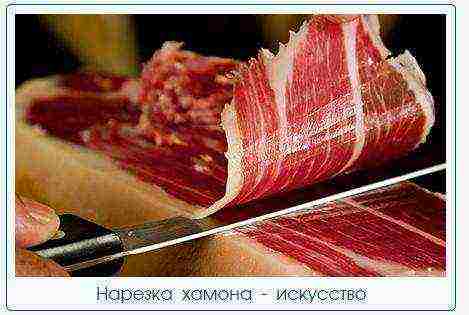 Jamon Iberico (Jamón Ibérico, Iberian ham) What is it and why is it so famous?
Jamon Iberico (Jamón Ibérico, Iberian ham) What is it and why is it so famous?
This gastronomic product is most associated with Spain and is rightfully considered its national pride. For the Spaniards, jamon is not just food, it is a necessary attribute and indicator of the quality of any feast, be it a wedding, christening, corporate party, or an ordinary private party at home or in a restaurant.
It seems incredible to a real Spaniard not to include jamon in the aperitif of a wedding celebration, or to invite guests home and not serve jamon as a snack.
It is very strange to meet a foreigner who, at least once tasted a real Iberian ham of good quality, would not enjoy its taste, or a Spaniard who would not include this ham in the list of foods that he misses the most while living away from Spain.
Because the jamon is an one of the symbols of Spain, there is a whole culture of its preparation, slicing and serving. Everything matters: the shape of the cut, how the thinly sliced slices of aromatic ham are placed on a flat plate, what drinks it accompanies (usually red wine, similar in quality to the type of jamon). All this, of course, is aimed at enhancement of taste served dish. There are even international jamon cutter contests that are getting more and more popular!
In order to appreciate and truly enjoy a real Iberian ham, let's let's figure it out what is it and how is it prepared... To make jamon, it is used back pork leg, which is salted in its raw form and cured for a long time without any heat or heat treatment. Made with the same technology front pork leg called pallet (paleta) or paletilla (scapula)... It is very easy to distinguish jamon from a pallet - paletilla looks more like a crescent and weighs on average 2-3 kg, but jamon, with weight 6-8 kg., looks like a big blob. The period during which the ham is dried in the cellar depends on the desired quality of the product, the breed of the pig, the size of the ham and can reach 36 months!
Do not be surprised that a product with such a seemingly simple appearance and cooking recipe has so many varieties. It is worth going to a specialty store - here you can find like an ordinary inexpensive jamon for 8-10 euros per kilogram, and gourmet brands, prices for which can reach 150 euros per kilogram. Of course, prices in good quality restaurants for a similar product will be much higher.
What caused such a difference in prices and quality of the offered ham? Let's take a closer look, starting with simple and inexpensive varieties, to give you a complete understanding of the main types of real Iberian jamon that you can find when traveling in Spain.
Types of jamon Iberico and its areas of origin
Jamón serrano Is a type of ham that is often given a name to add glamor jamon de bodega (jamóndebodega, wine cellar ham) or, referring to the breed of pig, they call jamon blanco (jamónblanco, white ham). This ham, which is made from pigs of the "white" race, that is from ordinary pigsnon-Iberian. These animals are raised on conventional farms. no special diet... The characteristic external features of the ham Jamónserranois his short and round shape, as well as the absence of veins of fat in the cut of meat, since with this type of growing pigs, all the fat is deposited on their sides, and the ham remains as lean as possible.
This type of jamon is mainly used in cooking as a snack. tapas, served in Spanish bars. The standard price of the finished product (cut and boneless) is about 20 euros per kilogram. The Spaniard may know where to find a good quality jamon in this category, but there is usually little difference between a Serrano jamon from Spain and any other ham produced outside of the country using dry-curing methods. For example, there are already farms in China that produce a product of similar taste and quality.
Jamon Iberico de Sebo (Jamónibéricodecebo), - this ham, which is produced from breeds of pigs obtained by crossing pigs of common breed with Iberian... This mixed breed is also farmed no special diet, but due to the presence of Iberian roots, the quality of the ham improves, which, of course, raises the price of the resulting ham.
Jamon Iberico de sebo de campo (Jamónibéricodecebodecampo), just like jamon de sebo is produced crossbred pigs, but unlike normal growing conditions on the farm, these animals are at least the last Free pasture for 60 days.
Jamon Iberico de Beyota (JamónibéricodebellotaIberian acorn jamon), is a ham produced by crossbred pigswho only ate acorns and herbs... Moreover, the last 2-3 months their lives were fed only acorns in an open pasture.
Jamon Iberico Puro de Beyota (JamónibéricopurodebellotaIberian purebred acorn ham) - just like the previous type, it assumes the presence of a special herbal and acorn diets in pigs. Only the ham of pigs is used for its preparation. purebred Iberian breed... This is the highest quality product. The price of the finished product (cut and boneless) will be not less than 100 euros per kilogram.
In addition to the varieties, the European Union has recognized 4 zones of origin for Iberian ham, which also affect the quality of the finished product. This is
- Jamón Ibérico D.O. "Jamón de Guijuelo" in the province of Salamanca, autonomous region of Castile and Leon
- Jamón Ibérico D.O. Jamón de Huelva, in Andalusia - Jamón Ibérico D.O.P. Los Pedroches, in the province of Cordoba (Andalusia) - Jamón Ibérico D.O. Dehesa de Extremadura, in the provinces of Cáceres and Bajados (Extremadura)
In general, when buying a jamon in Spain, the label is unlikely to deceive you about the name of the type of jamon (serrano, de sebo or beyote). It should be noted that the so-called "White marks" and little-known manufacturers quite often try to mislead inexperienced buyers (and not only from among tourists!) by adding fake names and photos next to the real name of the variety, to convince you of the high quality of your product. You can find photos of pastures, acorns, Iberian pigs on a product made from animal meat "White" breedgrown on the farm without any special diet... Who will pay attention to what an ordinary serrano jamon is holding in his hands if he sees black pigs in the photo?
It should be remembered that even in the same category, not all ham will be the same. We want to share with you some secrets About, how to choose a good quality jamon.
- When buying a whole ham, pay attention by the color of the hoof - it should be black, the ankle is as thin as possible, and the whole leg slightly elongated.
The black color of the hoof is not exclusive to Iberian pigs, but a short and large ham is characteristic of pigs raised on a farm, while its elongated shape suggests that the animal grew free.
- Fat distributed over the entire surface of the ham thin streaks.
Fat texture - soft, it melts even from contact with the hand. The best way to test this is to tilt the plate with the sliced ham. A high-quality ham has very thin fat, at room temperature it begins to thaw, and the slices stick slightly to the plate. You can tilt the plate almost perpendicularly - the slices of this ham are unlikely to fall off.
- Quite often you can see small white dots on jamon.
They arise from the crystallization of the protein contained in the product, which is a consequence of the drying process. This is not a drawback - their presence is an example of the quality of the ham and a confirmation of the observance of the technology of its preparation.

